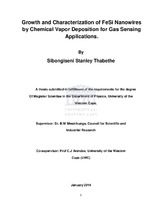| dc.contributor.advisor | Mwakikunga, B.W. | |
| dc.contributor.author | Thabethe, Sibongiseni Stanley | |
| dc.date.accessioned | 2015-05-29T14:52:27Z | |
| dc.date.available | 2015-05-29T14:52:27Z | |
| dc.date.issued | 2014 | |
| dc.identifier.uri | http://hdl.handle.net/11394/4239 | |
| dc.description | >Magister Scientiae - MSc | en_US |
| dc.description.abstract | FeSi nanowires were synthesized via a chemical vapor deposition method. Anhydrous FeCl3 powder in this case served as the Fe source and was evaporated at a temperature of 1100oC to interact with silicon substrates which served as the silicon source. The nanowires followed the vapor solid (VS) growth mechanism, which does not require the use of a metal catalyst; the native silicon oxide layer on the silicon substrates played the role of the catalyst in the growth of these nanostructures. A second growth mechanism, involving the use of a metal catalyst to assist in the growth of the nanowires was attempted by depositing a thin film of gold on silicon substrates. The reaction yielded SiOx nanowires; these results are discussed in detail in Chapter 5. All the nanostructures were characterized by X-ray diffraction (XRD), Transmission Electron Microscopy (TEM), Scanning Electron Microscopy (SEM), Photoluminescence Spectroscopy (PL), Raman Spectroscopy and Fourier Transform Infrared Spectroscopy (FTIR). | en_US |
| dc.language.iso | en | en_US |
| dc.publisher | University of the Western Cape | en_US |
| dc.subject | FeSi nanowires | en_US |
| dc.subject | Chemical vapor deposition | en_US |
| dc.subject | Band structures | en_US |
| dc.subject | X-ray diffraction | en_US |
| dc.title | Growth and characterization of FeSi nanowires by chemical vapor deposition for gas sensing applications | en_US |
| dc.type | Thesis | en_US |
| dc.rights.holder | University of the Western Cape | en_US |

